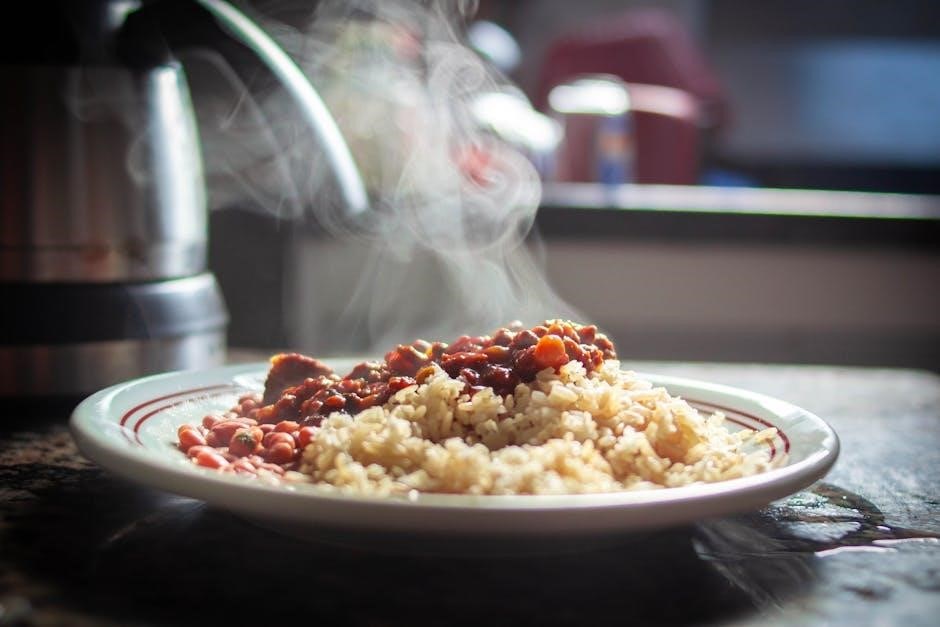Brown jasmine rice is a nutritious, whole-grain alternative to white rice, offering a nutty flavor and chewy texture. It combines the health benefits of brown rice with jasmine’s aromatic qualities, making it a versatile choice for various dishes.
1.1 What is Brown Jasmine Rice?
Brown jasmine rice is a whole-grain variety of jasmine rice, retaining its bran and germ layers. It has a light tan color, nutty flavor, and chewy texture. Unlike white jasmine rice, it undergoes minimal processing, preserving its natural nutrients, including fiber and minerals. Brown jasmine rice is a healthier alternative, offering more nutritional value and a richer taste compared to its white counterpart.
1.2 Benefits of Cooking Brown Jasmine Rice
Cooking brown jasmine rice provides numerous health benefits due to its high fiber content, which aids digestion and promotes satiety. It is rich in essential nutrients like manganese and selenium, supporting antioxidant functions. With a lower glycemic index than white rice, it is ideal for those managing blood sugar levels. Its nutty flavor and aromatic scent enhance meal satisfaction, making it a wholesome and flavorful addition to various dishes.
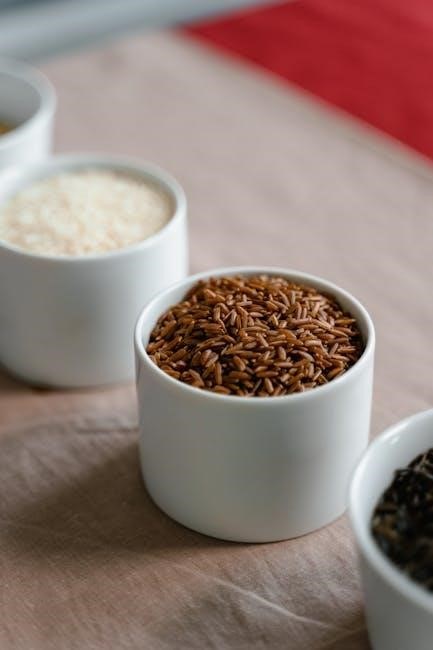
Cooking Brown Jasmine Rice: Basic Instructions
Rinse rice thoroughly, combine with 2 cups water per 1 cup rice, bring to a boil, cover, simmer for 40-45 minutes, then let rest covered.
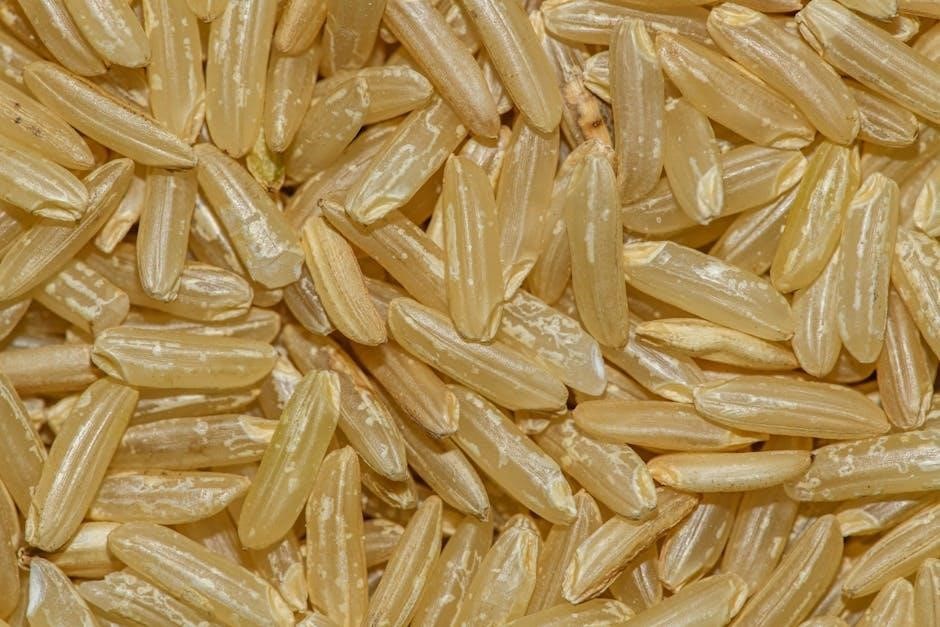
2.1 Materials Needed
To cook brown jasmine rice, you’ll need a medium saucepan with a tight-fitting lid, a fine mesh strainer for rinsing, and measuring cups for accurate water and rice ratios. Optional additions include olive oil or butter for flavor and salt for seasoning. Ensure all tools are clean and ready to start the cooking process effectively.
2.2 Water Ratio for Perfect Cooking

For brown jasmine rice, use a 2:1 water-to-rice ratio for optimal results. This ensures the rice cooks evenly without becoming mushy or undercooked. Rinse the rice first, then combine with water in a saucepan, cover, and simmer on low heat until the liquid is absorbed and the rice is tender, typically within 45 minutes.
2.3 Step-by-Step Stovetop Cooking
Rinse brown jasmine rice thoroughly under cold water. In a saucepan, combine 1 cup of rice with 2 cups of water. Bring to a boil, then reduce heat to low, cover, and simmer for 40-45 minutes. Turn off heat and let the rice steam, covered, for 10 minutes. Fluff with a fork before serving. This method ensures tender, perfectly cooked grains every time.
Advanced Cooking Methods
Explore beyond stovetop cooking with rice cookers, Instant Pots, or microwaves for perfectly cooked brown jasmine rice. These methods offer convenience and consistent results.
3.1 Using a Rice Cooker
Cooking brown jasmine rice in a rice cooker is straightforward and efficient. Rinse the rice thoroughly, then add 1 cup of rice to 1.5 cups of water. Place the mixture in the cooker, add optional salt or oil, and turn it on. The cooker automatically adjusts heat, ensuring perfectly cooked rice without constant monitoring. This method is ideal for achieving fluffy, flavorful results with minimal effort. Allow the rice to rest for 10 minutes before serving for optimal texture.
3.2 Instant Pot Method
Cooking brown jasmine rice in the Instant Pot is quick and easy. Rinse the rice and combine it with 1.5 cups of water for every 1 cup of rice; Add a pinch of salt or optional oil for flavor. Secure the lid, set the valve to sealing, and cook on high pressure for 20 minutes. Allow natural pressure release for 10 minutes before fluffing with a fork. This method ensures tender, perfectly cooked grains with minimal effort and time.
3.3 Microwave Cooking Instructions
To cook brown jasmine rice in the microwave, rinse the rice and combine 1 cup of rice with 2 cups of water in a microwave-safe dish. Cover with a lid or microwave-safe plastic wrap. Cook on high for 5 minutes, then reduce power to 50% and continue for 15 minutes. Let it stand, covered, for 5 minutes before fluffing with a fork. This method ensures tender grains with minimal supervision and effort, perfect for quick meal preparation.
Enhancing the Flavor
Elevate brown jasmine rice by using broth instead of water, adding herbs or spices, or incorporating oil or butter for a richer, more aromatic taste and texture.
4.1 Using Broth Instead of Water
Replace water with chicken, vegetable, or beef broth to infuse brown jasmine rice with savory flavor. This simple substitution enhances the dish, making it more aromatic and delicious. For added depth, mix in garlic or herbs during cooking. The result is a flavorful base that complements a variety of meals, from stir-fries to grilled meats, while maintaining the rice’s natural nutty undertones.
4.2 Adding Herbs and Spices
Infuse brown jasmine rice with fresh or dried herbs and spices for extra flavor. Try adding bay leaves, thyme, or rosemary for a Mediterranean twist, or cumin and turmeric for an earthy aroma. For a zesty touch, mix in grated ginger or lemon zest. Spices like cardamom and cinnamon add warmth, while fresh cilantro or mint provide brightness. These additions enhance the rice’s natural aroma and texture, making it a vibrant companion to any meal.
4.3 Incorporating Oil or Butter
Add a tablespoon of oil or butter to the pot for enhanced flavor and texture. Olive oil or coconut oil adds a subtle richness, while butter provides a creamy aroma. Stir the oil or melted butter into the rice before cooking for even distribution. This step not only improves taste but also helps prevent the rice from sticking together, resulting in fluffier grains. For extra depth, roast the rice in oil or butter before adding water.
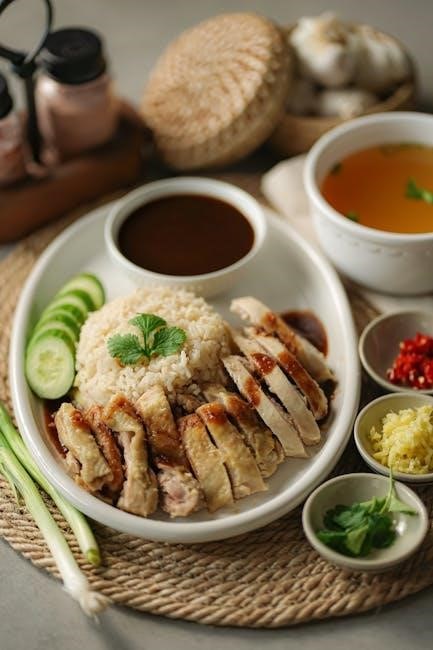
Serving Suggestions
Brown jasmine rice pairs perfectly with Asian-inspired dishes, grilled meats, and stir-fries. It also complements salads and curries, making it a versatile base for any meal.
5.1 Pairing with Asian-Inspired Dishes
Brown jasmine rice is a perfect complement to Asian-inspired dishes, such as Thai curries, stir-fries, and noodle-based meals. Its nutty flavor enhances the bold spices and fresh herbs commonly used in these recipes, while its chewy texture provides a satisfying contrast to soft vegetables and meats. It’s also an excellent side for dishes like pad thai, spring rolls, or satay, making it a versatile choice for any Asian-themed meal.
5.2 Combining with Grilled Meats
Brown jasmine rice pairs beautifully with grilled meats, such as chicken, steak, or shrimp, as its nutty flavor complements the smoky, charred notes of the meats. The rice’s chewy texture provides a satisfying contrast to the tender, grilled proteins. It’s especially delicious alongside herb-marinated grilled chicken or spicy BBQ sauces, creating a balanced and flavorful meal. This pairing is ideal for outdoor gatherings or casual dinners, offering a hearty and aromatic dish.
5.3 Adding to Salads and Stir-Fries
Brown jasmine rice is an excellent addition to salads and stir-fries, offering a nutty flavor and chewy texture. Its slightly sticky consistency helps bind ingredients, while its robust taste complements fresh vegetables, herbs, and savory sauces. Use it as a base for cold salads or mix it into stir-fries with grilled meats, tofu, or seafood for added depth. It pairs well with soy sauce, garlic, and ginger, making it a versatile choice for quick, flavorful meals.
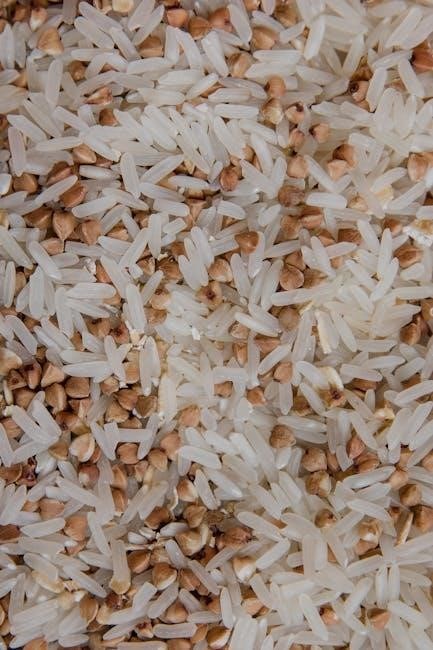
Health Benefits of Brown Jasmine Rice
Brown jasmine rice is rich in fiber, vitamins, and minerals, making it a healthier option than white rice. It supports digestive health and provides sustained energy.
6.1 High Fiber Content
Brown jasmine rice contains about 3.5 grams of fiber per cooked cup, aiding digestion and promoting satiety. Its high fiber content supports healthy blood sugar levels and gut health, making it a nutritious choice for balanced diets.
6.2 Nutritional Value Comparison
Brown jasmine rice is richer in nutrients compared to white jasmine rice, with higher fiber and more vitamins like B1 and B6. It offers a better protein content and fewer empty calories, making it a healthier option while retaining jasmine’s distinctive aroma and flavor.
6.3 Digestive Health Advantages
Brown jasmine rice is high in dietary fiber, containing about 3.5 grams per cooked cup. This fiber helps prevent constipation and supports gut health by promoting beneficial bacteria. Additionally, it is a good source of manganese and magnesium, which aid in enzyme function and digestion. The slower digestion of whole grains like brown jasmine rice can help stabilize blood sugar levels, making it a better choice for digestive health compared to refined options.
Storage and Reheating
Cool cooked brown jasmine rice to room temperature, then store in an airtight container in the fridge for up to 5 days. Reheat safely using a microwave or steamer.
7.1 Proper Storage Techniques
To maintain freshness, store brown jasmine rice in an airtight container in a cool, dry place. Cooked rice should be cooled to room temperature within two hours, then refrigerated. For longer storage, freeze in an airtight container or freezer bag, ensuring no moisture is present. Proper storage prevents spoilage and retains the rice’s natural aroma and texture.
7.2 Reheating Cooked Rice Safely
Reheat cooked brown jasmine rice safely by using a microwave or stovetop. Add a splash of water, cover, and heat gently. Ensure it reaches 165°F to prevent foodborne illness. Avoid overheating, as it can dry out the rice. For best results, reheat within a day of cooking. Refrigerated rice should be reheated within three days, while frozen rice can be reheated directly from the freezer.
Common Mistakes to Avoid
Common mistakes include overcooking, using incorrect water ratios, and not rinsing. These errors can lead to mushy texture or uneven cooking, affecting final quality.
8.1 Overcooking the Rice
Overcooking brown jasmine rice can result in a mushy, unappealing texture. To avoid this, ensure the rice is cooked until just tender, then allow it to rest off the heat. Properly covering the pot and maintaining low heat during cooking helps prevent overcooking. Always follow the recommended cooking time, typically 40-45 minutes on the stovetop, to achieve perfectly cooked grains.
8.2 Incorrect Water Ratios
Using the wrong water ratio can lead to undercooked or mushy brown jasmine rice. Generally, 2 cups of water per 1 cup of rice is ideal. Too little water results in dry, crunchy grains, while excess water causes a soggy texture. Measure accurately to ensure perfectly cooked rice. Adjustments may vary slightly by brand or method, so always check package instructions for specific guidelines to achieve the best results.
8.3 Not Rinsing the Rice
Skipping the rinsing step can affect the texture and flavor of brown jasmine rice. Rinsing removes excess starch, reducing stickiness and ensuring fluffy grains. It also washes away impurities and excess arsenic, improving taste and nutritional value. Rinse under cold water until it runs clear for better cooking results and a more palatable dish. This simple step is crucial for achieving perfectly cooked, separate grains every time.
Brown jasmine rice offers a perfect blend of nutrition, flavor, and versatility, making it a great addition to various meals. With proper cooking techniques, it delivers a tender, aromatic texture. Whether cooked stovetop, in a rice cooker, or Instant Pot, it adapts well to different methods. Enhancing its flavor with broth, herbs, or butter elevates its appeal. Rich in fiber and nutrients, it supports a healthy diet. Store it properly and enjoy its benefits in countless dishes, from stir-fries to grilled meats.
